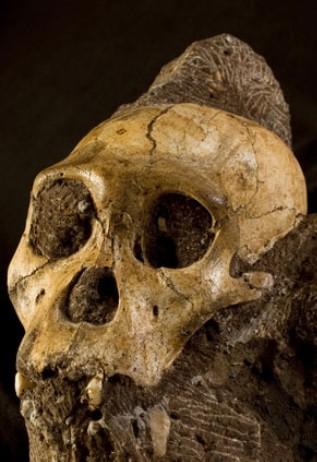
Science and Technology
科技
Human evolution
人類進化史
You look familiar
似曾相識
Another piece of humanity's family tree is fitted into place
南方古猿sediba的發現填補了人類家族譜系的關鍵空白
THE opening scene of Mel Brooks's film "History of the World: Part One" dispenses with human origins in one line: "And the ape stood, and became man."
梅爾·布魯克斯執導的電影"世界史:序幕"開場僅用一句話就概括了人類起源:"類人猿直立起來,變成了人類。"
Would that it were that easy for palaeontologists to sort out.
要是古生物學家也能如此輕而易舉地闡釋人類進化的奧秘就好了。
The transition to humanity is generally agreed to have occurred between Australopithecus, a genus of small-brained, bipedal primates whose most famous member is a fossil nicknamed "Lucy", and the big-brained species Homo erectus.
人們普遍認為人類是由南方古猿和直立人之間的某個物種演化而來。南方古猿頭部較小,屬雙足靈長類動物,其最有名的家族成員是一具被稱做"露西"的化石,比較而言,直立人的頭部就大多了。
But pinning down when precisely this took place, and which of the various australopithecine species were involved, has been challenging.
不過,要想確定確切的人類演化時間和哪些南方古猿物種參與了演化,仍是極具挑戰性的課題。
Now the most human-like australopithecine found to date is clarifying things-and staking a claim to be the species from which early humans evolved.
目前,迄今為止發現的與人類最為相似的南方古猿正逐漸解開這團迷霧——它闡明了早期人類是由哪個物種演化而來的。
Fossils of the new species, Australopithecus sediba, were discovered in 2008 in a cave in South Africa. Initial research, led by Lee Berger of the University of the Witwatersrand, in Johannesburg, concluded that the species came too late in the fossil record to be the ancestor of the Homo lineage.
2008年在南非一個洞穴內發現一個新物種化石,稱做南方古猿sediba。約翰內斯堡金山大學的李·伯格爾領導的最初研究結果表明南方古猿sediba在化石記錄中出現的年份過晚而無法被認定為人類的祖先。
This week, however, a range of new research into sediba, again led by Dr Berger, has been published in Science.
然而本周,李·伯格爾博士領導的一系列關于sediba的最新研究成果在《科學》雜志上發表。
These studies conclude that sediba did in fact predate Homo erectus and, moreover, that parts of its anatomy are surprisingly similar to modern man.
這些研究結果表明,南方古猿sediba確實早于直立人存在,并且它的一些骨骼結構與現代人類有著驚人的相似之處。
The fossils examined in the Science papers are of an adolescent boy and an adult woman.
發表在《科學》雜志的該篇論文其研究對象為一個小男孩和一個成年婦女的化石。
They are well preserved, and encased in sediments that allow uncommonly precise dating.
這些化石保存完好,被封存在可進行精確年代測定的沉積物中,這實屬罕見。
They lived 1.977m years ago, predating the appearance of Homo erectus by 77,000 years.
他們生活于197.7萬年前,比直立人早出現7.7萬年。
The period is an especially muddled one for palaeontology, being full of fragmentary fossils that are difficult to assign either to Homo or to Australopithecus.
該時期屬于古生物學上極其混亂的年代,大量化石碎片都很難歸類到直立人或南方古猿身上。
The sediba fossils, by contrast, have some of the most complete features in the early human record.
比較而言,南方古猿sediba化石具備了早期人類一些最完整的特征。
The new studies centre on the most telling bits of anatomy in the story of human evolution: the brain, pelvis, hands and feet.
新研究集中于與人類進化史相關的一些最具說服力的特征:如大腦,骨盆,手和腳。
The brain itself does not fossilise, but the inside of the cranium retains an impression of its contours.
大腦本身不會變成化石,但它在顱骨內保留的輪廓特征仍依稀可見。
The researchers mapped these with high-powered X-ray beams to create a three-dimensional model of the surface of sediba's brain.
研究人員采用高功率X射線束對其進行映射并繪制出sediba大腦表面的三維模型圖。
They found that its size was on a par with other australopithecines, but its shape was more like that of a human brain.
他們發現sediba腦部大小與其它南方古猿并無分別,但形狀卻更接近人腦。
Specifically, the frontal lobes, which are the seat in modern humans of higher cognitive functions such as abstract reasoning, looked more humanlike in sediba's brain than they do in the brains of other australopithecines.
尤其是作為人類抽象推理等高認知功能區域的腦前葉部分,sediba比其它南方古猿更象人類。
That suggests the neurological changes which gave rise to humanity may have predated the brain's expansion—an event that had, hitherto, been regarded as crucial to the emergence of humans.
這表明產生人類的神經系統變化可能早于南方古猿大腦的擴張——大腦擴張至今仍被認為是人類出現的重要因素。
The hands, feet and pelvis of sediba indicate that it both climbed trees and walked upright, though with a different gait from that of humans or chimpanzees.
南方古猿sediba的手、腳和盆骨表明盡管其步法與人類或黑猩猩有所不同,但它能夠爬樹和直立行走。
The species may have been a toolmaker, as its hand allowed for a human-like grip.
這種物種可能還會制造工具,因為它們的手能象人類那樣緊握。
Sediba's pelvis, an upright butterfly shape, is likewise reminiscent of the human one.
南方古猿sediba呈直立蝴蝶狀的盆骨同樣與人類相似。
It therefore sheds light on a longstanding debate: whether it was bipedalism or giving birth to babies with large heads that drove changes in the shape of the human pelvis.
因此它為長期爭論的問題提供了很好的闡釋:人類的盆骨形狀是源自于雙足行走還是為了生育大頭嬰兒。
Adult sediba (and therefore, presumably, their babies) had small heads, which indicates that walking upright was the advantage brought by the modern pelvis.
由于成年南方古猿sediba(據此可推知他們的子女)頭部很小,這表明現代人的盆骨可帶來直立行走的好處。
All of which makes sediba more similar to modern humans than are other australopithecines-and more similar, even, than Homo habilis, until now seen as one of the earliest humans.
所有這些都讓南方古猿sediba比其它靈長類更象現代人——甚至比至今被認為是最早人類之一的"能人"還象現代人。
The consensus had been that habilis was a transitional form between Australopithecus and Homo erectus.
人們一致認為"能人"是南方古猿和直立人之間的過渡物種。
Dr Berger posits that sediba may have evolved directly into Homo erectus, leaving habilis as an evolutionary sideline, and not even part of the genus Homo.
李·伯格爾博士推斷南方古猿sediba可能直接進化成了直立人,這使"能人"成為進化的旁支,甚至不是人屬的一部分。
Slowly, then, the origin of the strange assemblage of characters that makes a human being human is emerging.
逐漸地,人類自身奇怪性格組合的起源開始出現。
As the oracle said, the beginning of wisdom is: know thyself.
正如智者所說,智慧的開端是認識自身。











